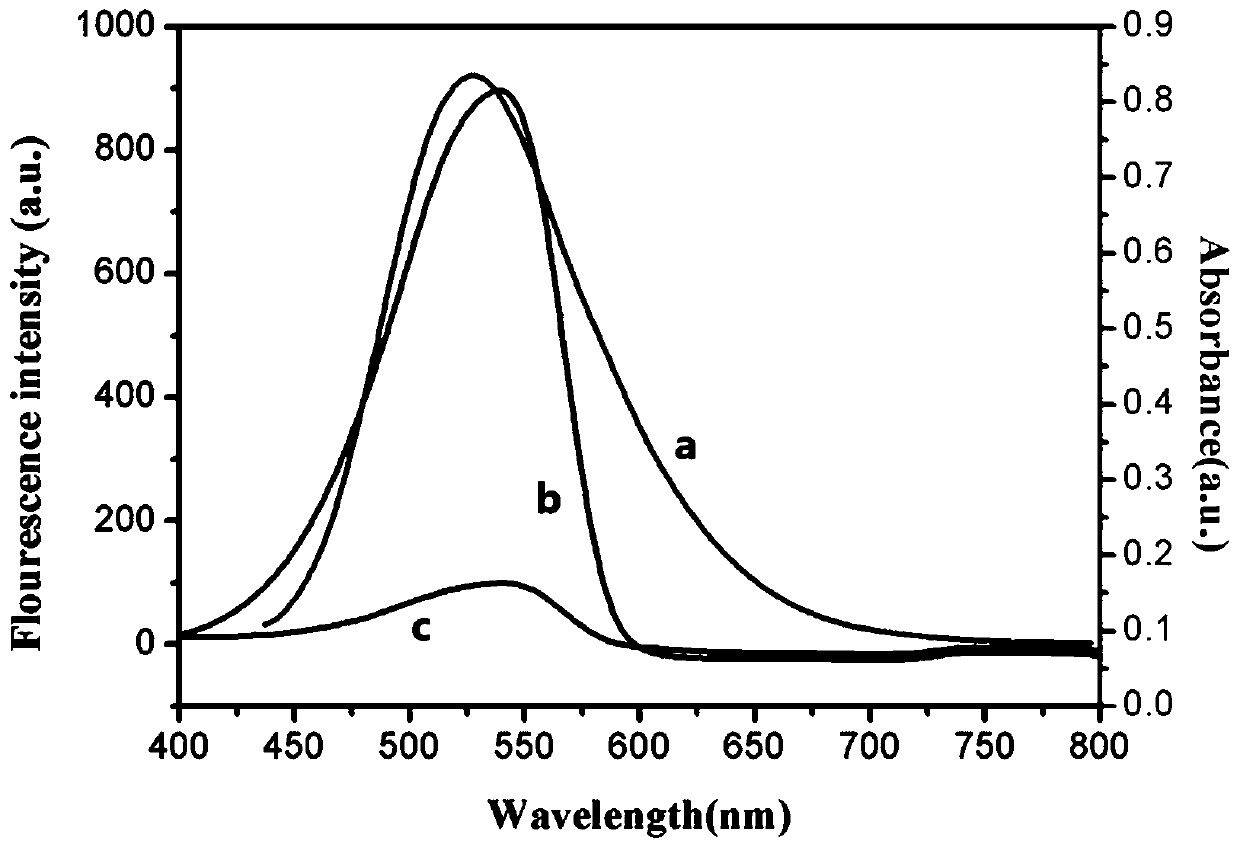Fluorescent carbon dot nano-probe for detecting hydrogen sulfide and imaging hydrogen sulfide in living cells based on inner filter effect, and using method thereof
A technology of fluorescent carbon dots and nano-probes, which is applied in the field of biochemical analysis, can solve the problems such as the inability to continuously detect the content of hydrogen sulfide, and achieve the effect of high selectivity and low cost
- Summary
- Abstract
- Description
- Claims
- Application Information
AI Technical Summary
Problems solved by technology
Method used
Image
Examples
Embodiment 1
[0033] Preparation method of fluorescent carbon dot nanoprobe for detection of hydrogen sulfide and intracellular hydrogen sulfide imaging based on inner filter effect:
[0034] 1. Synthesis of Fluorescent Carbon Nanodots
[0035] Fluorescent carbon nanodots (CDs) were prepared by pyrolyzing tomatoes, as follows: Weigh 5.0 g of fresh tomatoes in a mortar, grind them fully, filter them through a 150-mesh filter, take 3 mL of the filtrate into a hydrothermal reaction kettle, and add 20 mL of ultrapure water was heated to 250 °C and stirred. After 10 hours, the heating was stopped and the solution was naturally cooled to room temperature. After filtration, the filtrate was collected in a dialysis bag (MWCO: 1 kDa, poresize: ca. 1.0 nm) in an ultrapure water environment. After photodialysis for 24 h, the supernatant was taken and stored at 4°C in the dark. figure 1 The TEM images and particle size distribution diagrams of the synthesized green carbon quantum dots are given. It ca...
Embodiment 2
[0043] 1. Synthesis of Fluorescent Carbon Nanodots
[0044] Fluorescent carbon nanodots (CDs) were prepared by pyrolyzing tomatoes, as follows: Weigh 5.0 g of fresh tomatoes in a mortar, grind them fully, filter them through a 150-mesh filter, take 3 mL of the filtrate into a hydrothermal reaction kettle, and add 21 mL of ultrapure water was heated to 250 °C and stirred. After 10 hours, the heating was stopped and the solution was naturally cooled to room temperature, filtered, and the filtrate was taken in a dialysis bag (MWCO: 1 kDa, poresize: ca. 1.0 nm) in an ultrapure water environment. After photodialysis for 24 h, the supernatant was taken and stored at 4°C in the dark.
[0045] 2. Synthesis of DMI
[0046] 2,3,3-Trimethyl-3H-indole (1.6g, 10mmol) and methyl iodide (2.84g, 20mmol) were mixed and dissolved in 10mL of acetonitrile, refluxed at 60°C for 11h under argon protection, and cooled to room temperature naturally , a light pink precipitate was obtained, which was...
Embodiment 3
[0052] 1. Synthesis of Fluorescent Carbon Nanodots
[0053] Fluorescent carbon nanodots (CDs) were prepared by pyrolyzing tomatoes, as follows: Weigh 5.0 g of fresh tomatoes in a mortar, grind them fully, filter them through a 150-mesh filter, take 3 mL of the filtrate into a hydrothermal reaction kettle, and add 22 mL of ultrapure water was heated to 250 °C and stirred. After 10 hours, the heating was stopped and the solution was naturally cooled to room temperature, filtered, and the filtrate was taken in a dialysis bag (MWCO: 1 kDa, poresize: ca. 1.0 nm) in an ultrapure water environment. After photodialysis for 24 h, the supernatant was taken and stored at 4°C in the dark.
[0054] 2. Synthesis of DMI
[0055] 2,3,3-Trimethyl-3H-indole (4.8g, 30mmol) and iodomethane (8.52g, 60mmol) were mixed and dissolved in 10mL of acetonitrile, refluxed at 60°C for 11h under argon protection, and cooled to room temperature naturally , a light pink precipitate was obtained, which was f...
PUM
 Login to View More
Login to View More Abstract
Description
Claims
Application Information
 Login to View More
Login to View More - R&D
- Intellectual Property
- Life Sciences
- Materials
- Tech Scout
- Unparalleled Data Quality
- Higher Quality Content
- 60% Fewer Hallucinations
Browse by: Latest US Patents, China's latest patents, Technical Efficacy Thesaurus, Application Domain, Technology Topic, Popular Technical Reports.
© 2025 PatSnap. All rights reserved.Legal|Privacy policy|Modern Slavery Act Transparency Statement|Sitemap|About US| Contact US: help@patsnap.com



